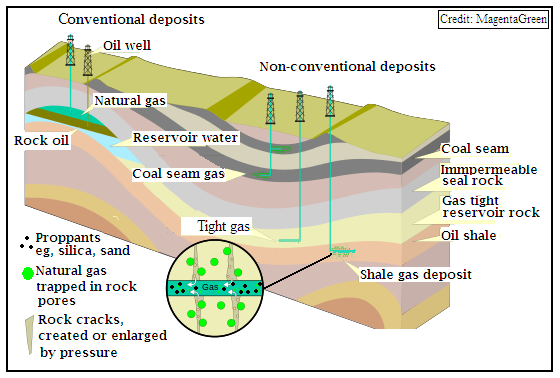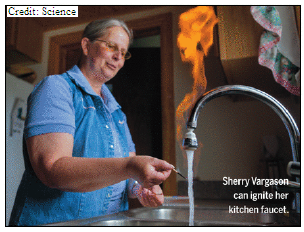Methane pollution is rearing its head as the new GHG threat, says S.Ananthanarayanan.
The last half century has seen humanity coming to grips with the harm caused by CO2 emissions of burning coal for heat and generation of electricity. And the world is striving to adapt technology and lifestyles to undo the damage done. An apparent solution, but also a threat, is the maturing of methods to tap large underground reserves of natural gas, which can partly replace coal as an energy source.
The journal, Science, of the American Association for the Advancement of Science (AAAS), has released a special issue,The Great Gas Boom, which discusses the ‘promise and the peril’ of this resource, which the US is rapidly exploiting, but which some countries, like France and Bulgaria and even some States within the US, have put on hold
Gas and coal
The earth’s store of coal, natural gas and petroleum has arisen from vegetable matter buried and compressed over millions of years. The vegetable matter itself arose by fixing atmospheric CO2 through photosynthesis. Photosynthesis uses the energy in sunlight to separate both the carbon in CO2 as well as the hydrogen in H2O (water), to create, with some oxygen, the basic carbohydrates, like sugars and starches. When decomposed plant matter was buried and cut off from oxygen, and subject to bacterial action, oxygen content was further reduced and under intense pressure, hydrocarbons, which consist only of hydrogen and carbon, were formed in the form of gas and petroleum. And in places where conditions were right, even hydrogen was removed, and vegetable matter was reduced to just carbon, as deposits of coal. Coal can thus be considered as a hydrocarbon with the hydrogen content removed. Hydrogen removal can be likened to burning out the hydrogen part, which would release energy, and coal is hence left with less energy than hydrocarbons.
Another way of looking at this is to say that hydrocarbons are sources of more energy than coal. And the good part is that the additional energy comes from hydrogen, whose burning does not create CO2. Tapping sources of underground hydrocarbons, like natural gas, thus amounts to getting hold of solar energy of past eons, stored in ways that are more than just as carbon, so that we can power modern living without causing to the environment as much damage as we are when we use energy derived from coal alone.
Hydrocarbons in underground reservoirs occur both in the liquid form of petroleum as well as in the form of natural gas. The extraction and refinement of petroleum, whose reserves are placed at around 200 billion tonnes, which is less than a fourth of reserves of recoverable coal, is a major industry and the price of oil is a vital factor in the world’s economy. And for natural gas, while this is also present along with oil deposits, there are also large reservoirs of just gas, mainly in Russia and the Middle East. While the gas that is found with oil is usually flared and lost, except where there are local consumers, larger finds of natural gas have led to the laying of gas pipelines and power generation from gas at distances from the sources. But a further, equally large source of natural gas is in the reserves trapped in rock formations known as shale.
Shale gas
Shale consists of flakes of rock formed out of the compaction of fine grains of clay, minerals or quartz. Shale occurs where the original material had more than 1% of carbonaceous content and the characteristic of shale is that it occurs in sheets that can be prized apart, although the sheets are well compacted at great depths below the earth’s surface. Shale gas is natural gas that is trapped between rock layers in shale formations. Very large reserves of shale gas have been discovered and exploited in the US since a century and there are many more reserves, the largest being in China. As the US and China are major importers of petroleum, shale gas use has impaced the oil market, apart from being a replacement for coal.
But extraction of shale gas presents its own set of problems. In the case of a bore into the earth for water or for oil, the liquid, which is contained in the rock formation, flows into the bore and collects for being pumped out. But with shale gas, shale does not allow gas to flow and it is not possible to collect gas justby a borehole entering a shale formation. The way to access shale gas has hence been from natural fractures in the shale, or, in recent times, by artificially creating extensive fractures around the bore hole, a method called fracturing or fracking.

Early methods of fracking used explosives, but the current method is hydraulic fracking, where water is forced into the bore hole, which bends horizontally, under very high pressure. The high pressure is able to overcome the pressure of the load of soil above the shale and water enters between the sheets of shale, to release the gas. The water used is mixed with sand or other mineral particles, called proppants, which remain when flows out and keep the layers of shale propped apart.
The special issue of Science recounts that fracking was first tried in the State of Kansas in USA nearly 70 years ago and has now grown into a booming industry with thousands of bores drilled, largely in the States of Pennsylvania, Texas and Louisiana in the USA. Shale gas now accounts for 40% of the natural gas produced in the US and is growing. The use of coal is falling, USA has reduced its level of CO2 emission and industry is moving to the US, while USA positions itself as an exporter of natural gas.
The down side
On the downside, there are controversies galore. For one, there is the huge quantity of water used, some 15 million liters for one well, says Erik Stocksad, author of one of the pieces in Science. And the water emerges contaminated with methane, the chief component of natural gas, and has to be put away (in many cases it is re-used to frack another well). Next, the fear of contamination of aquifers feeding supplies of drinking water. And then the evidence of leakage of methane gas from well bores as well as from the pipelines that distribute shale gas. Methane, whose molecular structure has a carbon atom surrounded by four hydrogen atoms, is like a spring-loaded flywheel among molecules, and has high capacity to absorb heat. This makes methane a potent Green House Gas many times worse than CO2, and it is felt by many that injecting methane into the atmosphere would negate the benefits of reduction in emission of CO2. And another serious consideration is that promoting shale gas, with its limited benefits, if any, would take away from the urgency of the need to limit CO2 emissions. There are even the fears that fracking could lead to siesmic disturbance and earthquakes.
In defense of fracking, experts say the pressures at the great depths at which fracking happens would seal any larger cracks in the rock, so that there is no danger to drinking water supplies. Studies with tracers injected into six commercial wells have shown no trace of contamination leaks, the Science article says. On the other hand, the article says, leakage from the casing of the wells is a real risk, with documented instances. One of the articles even displays a picture of Sherry Vargason of Pennsylvania showing water from a faucet bursts into flame when a match is applied! Experts however, defend themselves by saying that there is no clear evidence of the leaks having been caused by fracking as seepage of methane could happen because of natural geologic faults. And also that as gas companies gain experience, the risk of leaks are coming down.


But the controversy rages, with communities regrouping to contain what is considered dangerous manipulation of the natural balance. In the meantime, one team is “documenting water quality along the border between frack-free New York and frack-heavy Pennsylvania….and gas companies are funding their own vast surveys of pre-drilling water quality- even if only to defend themselves against post-drilling lawsuits,” says the article in Science.
Is there life down there?
Another interest in pumping water into shale formations is to discover the nature of micro-organisms that these isolated crevices of the earth might harbour. Writing in the special issue of Science, Elizabeth Pennisi describes the work of researchers Paula Mouser of Ohio State University and and Shikha Sharma of West Virginia University at Morgantown.
While analysing carbon isotopes in the water from aquifers and also fracking wells, Sharma noticed that the water flowing out “had a very different signature” than the water that was sent in, and the data suggested the presence of ancient, methane producing organisms. Paula Mouser, working independently, had also seen evidence of salt tolerant organisms in fracking wells.
The two have now got together and plan, later this year, to collect the original water from the wells, when they are bored, and before fracking water is pumped in, “to get a full sense of what’s down there.”
Energy companies also have an interest in the nature of micro-organisms, as these could cause corrosion of equipment or toxic contamination of the gas or even consumption of the methane before it reaches consumers.

------------------------------------------------------------------------------------------